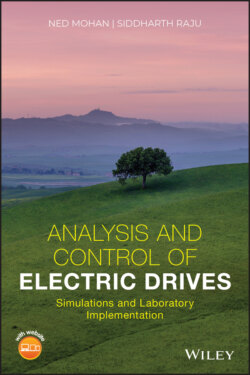Читать книгу Analysis and Control of Electric Drives - Ned Mohan - Страница 38
Solution
Оглавление1 From Newton’s Law of Motion, in Fig. 2-6a, to accelerate a differential mass dM at a radius r, the net differential force df required in a perpendicular (tangential) direction, from Eq. (2-1), is(2-11)
where the linear speed u in terms of the angular speed ωm (in rad/s) is
(2-12)
Multiplying both sides of Eq. (2-11) by the radius r, recognizing that (r df) equals the net differential torque dT and using Eq. (2-12),
(2-13)
The same angular acceleration is experienced by all elements of the cylinder. With the help of Fig. 2-6b, the differential mass dM in Eq. (2-13) can be expressed as
(2-14)
where ρ is the material density in kg/m3. Substituting dM from Eq. (2-14) into Eq. (2-13),
(2-15)
The net torque acting on the cylinder can be obtained by integrating over all differential elements in terms of r, θ, and ℓ as
(2-16)
Carrying out the triple integration yields
(2-17)
(2-18)
where the quantity within the brackets in Eq. (2-17) is called the moment‐of‐inertia J, which for a solid cylinder is
(2-19)
Since the mass of the cylinder in Fig. 2-6a is , the moment‐of‐inertia in Eq. (2-19) can be written as
(2-20)
1 Substituting r1 = 6 cm, length ℓ = 18 cm, and ρ = 7.85 × 103 kg/m3 in Eq. (2-19), the moment‐of‐inertia Jcyl of the cylinder in Fig. 2-5a is
Fig. 2-6 Calculation of the inertia, Jcyl, of a solid cylinder.
The net torque TJ acting on the rotating body of inertia J causes it to accelerate. Similar to systems with linear motion, where fM = M a Newton’s Law in rotational systems becomes
(2-21)
where the angular acceleration α(=dω/dt) in rad/s2 is
(2-22)
which is similar to Eq. (2-18) in the previous example. In MKS units, a torque of 1 Nm acting on the inertia of 1 kg ⋅ m2 results in an angular acceleration of 1 rad/s2.
In systems such as the one shown in Fig. 2-7a, the motor produces an electromagnetic torque Tem. The bearing friction and wind resistance (drag) can be combined with the load torque TL opposing the rotation. In most systems, we can assume that the rotating part of the motor with inertia JM is rigidly coupled (without flexing) to the load inertia JL. The net torque, which is the difference between the electromagnetic torque developed by the motor and the load torque opposing it, causes the combined inertias of the motor and the load to accelerate in accordance with Eq. (2-22):
(2-23)
where the net torque TJ = Tem − TL and the equivalent combined inertia is Jeq = JM + JL.
